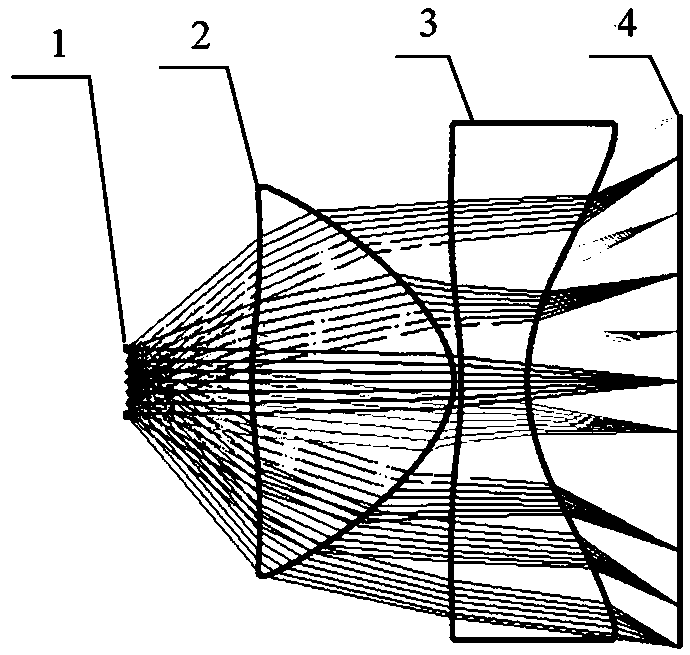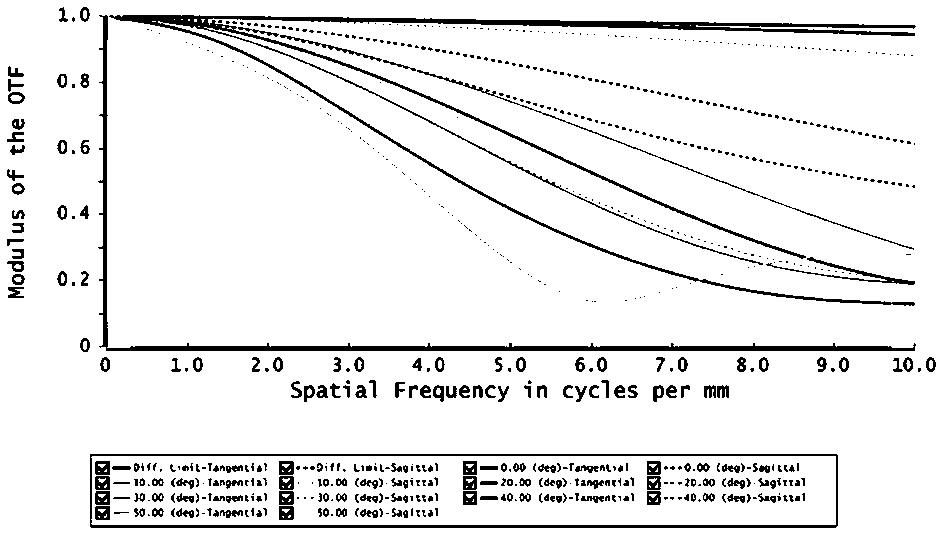An optical system suitable for virtual reality equipment
An optical system and virtual reality technology, applied in the field of optical systems, can solve problems such as incompatibility, and achieve the effects of reducing processing costs, large field of view, and reducing chromatic aberration
- Summary
- Abstract
- Description
- Claims
- Application Information
AI Technical Summary
Problems solved by technology
Method used
Image
Examples
Embodiment 1
[0026] See attached figure 1 , is a schematic structural diagram of an optical system suitable for a virtual reality device provided in this embodiment. It includes a diaphragm 1, a positive power lens 2, a negative power lens 3 and a liquid crystal display 4 arranged in sequence along the optical axis. The light emitted by the liquid crystal display screen 4 sequentially passes through the negative power lens 3 and the positive power lens 2, and then enters the aperture 1, and then enters the pupil of the human eye. The two surfaces of the positive power lens 2 are aspheric surfaces, the surface opposite to the diaphragm is a convex surface, the surface opposite to the negative power lens 3 is concave, and both surfaces of the negative power lens 3 are concave aspherical surface. The optical system provided by this embodiment achieves the following optical properties:
[0027] (1) In this embodiment, the diagonal length of the liquid crystal display 4 is 5.5 inches, the re...
Embodiment 2
[0043] The structure of the optical system provided by this embodiment is as figure 1 As shown, it achieves the following optical properties:
[0044] (1) In this embodiment, the diagonal length of the liquid crystal display 4 is 5.5 inches, the resolution is 2560×1440, the number of pixels per inch (ppi, pixels per inch) is 538, and the pixel size is 47.25 μm, thus It can be calculated that the Nyquist frequency of the optical system is 10 line pairs / mm, and the field angle of the monocular diagonal of the optical system is 90 degrees.
[0045] (2) The focal power of lens 2 with positive refractive power is 0.05821mm -1 , the material is PMMA, the refractive index is 1.49, and the dispersion coefficient is 57.44; the focal power of the negative power lens 3 is -0.04821mm -1 , the material is POLYCARB, the refractive index is 1.58, and the dispersion coefficient is 29.9.
[0046] (3) The surface of lens 2 with positive dioptric power is a convex aspheric surface relative to...
PUM
 Login to View More
Login to View More Abstract
Description
Claims
Application Information
 Login to View More
Login to View More - R&D
- Intellectual Property
- Life Sciences
- Materials
- Tech Scout
- Unparalleled Data Quality
- Higher Quality Content
- 60% Fewer Hallucinations
Browse by: Latest US Patents, China's latest patents, Technical Efficacy Thesaurus, Application Domain, Technology Topic, Popular Technical Reports.
© 2025 PatSnap. All rights reserved.Legal|Privacy policy|Modern Slavery Act Transparency Statement|Sitemap|About US| Contact US: help@patsnap.com



